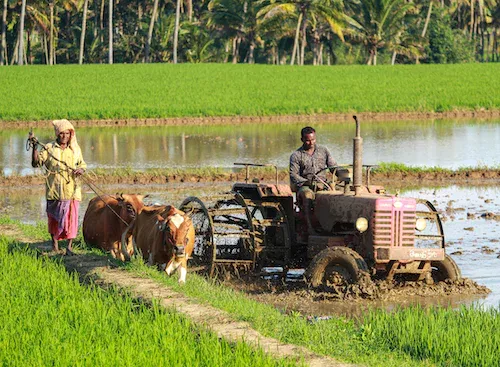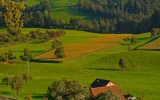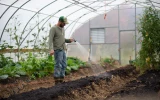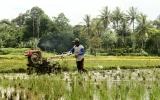When Does a Smallholding Become a Farm – Exactly?
To be considered a small farm, a smallholding will be allowed for larger-scale production of food and other agricultural products. This article will explore the differences between smallholdings and farms and attempt to answer the question of which one is which.
A smallholding becomes a farm when it is actively used for the production of food, crops, or other agricultural products for sale. It becomes a farm when it has at least 2 acres of cultivated land and the landowner uses the smallholding for commercial purposes and hires staff to assist in food production.
Now we know when exactly a smallholding becomes a farm, let's look at the implications between the two, such as the amount of land and animals owned.
Summary
- A smallholding is a small area of land used to produce food.
- It can become a farm when the land owner is operating the smallholding on a commercial basis, and when they are employing workers to help with the production of food.
- A smallholding is usually classified as a farm when it has a turnover of over £1,000 per annum.

On this page:
Situations When A Smallholding Exactly Becomes a Farm
There are a variety of factors that contribute to a smallholding becoming a farm. This list will explore these factors and the instances or situations when a smallholding can be considered a farm.
1. When the smallholding produces a significant amount of agricultural products for sale in the market
The smallholding must have enough land to support larger production, such as at least five to ten acres of usable land for crops, pastures, and other farming activities. The smallholding must be able to market the products it produces and have a system in place to ensure that the products reach its customers in a timely and cost-effective manner.
2. When the smallholding is used to raise livestock for meat or dairy production
The smallholding is a small plot of land used to raise animals for meat or dairy production. It is typically smaller than a farm but has the potential to become one. The land is used to raise pigs, cows, chickens, goats, and other animals.
The animals are kept in pens or pastures and are fed a diet specific to their species. Water is provided and the pens are cleaned regularly. The animals are monitored for health and provided with proper care and shelter.
All products produced from the smallholding are inspected and certified for quality. With the proper care and attention, the smallholding can be turned into a profitable farm.
3. When smallholding utilizes modern farming techniques such as crop rotation or irrigation systems to increase productivity
When a smallholding utilizes modern farming techniques such as crop rotation or irrigation systems, it can become a full-fledged farm. Crop rotation involves growing different crops in the same area in successive growing seasons, which increases productivity and maintains soil fertility.
Irrigation systems, such as sprinklers or drip irrigation, can be used to provide water to crops in areas where rainfall is scarce. These modern farming techniques can help a smallholding transition into a larger farm, as they promote higher yields and better soil health.
Additionally, modern farming techniques can be integrated with traditional animal husbandry and pasture management to create a more comprehensive and efficient farm.
4. When the smallholding is used to produce crops or livestock for commercial sale
This can involve planting crops and harvesting them for sale, or raising animals such as cows, pigs, sheep, and chickens, and selling them for a profit.
- The farmer must also have adequate farmland, barns, and other facilities to care for the animals and store the crops.
- The farmer must also have the knowledge and skills necessary to manage the production, marketing, and sales of the products they are producing.
- In addition, they must have a business plan and access to the necessary capital to invest in the land, livestock, and additional equipment and supplies.

5. When the smallholding is used to produce crops or livestock for other commercial farms
A smallholding can easily become a farm when the land is used to produce crops or livestock for other commercial farms. For example, a smallholding may have a few acres of land that can be used to grow wheat, barley, oats, or other grains.
The smallholding may also have enough land to raise cows, goats, sheep, chickens, or other animals for sale to other farms. In addition to these crops and animals, a smallholding may also have an orchard, where fruits and nuts can be grown for sale.
Additionally, a smallholding may also have a small pond or lake for fishing and/or for providing a water source for the animals.
6. When the smallholding is used to produce crops or livestock to be sold in local markets or businesses
A smallholding can become a farm when the land is used to produce a variety of crops or livestock for sale in local markets or businesses. The farmer will also need to be knowledgeable about the best practices for raising the chosen crop or livestock, as well as the laws and regulations surrounding the sale of such products.
7. When the smallholding is used to produce crops or livestock for export
A smallholding can become a farm when the land is used to produce crops or livestock for export.
- The smallholder will need to build the necessary infrastructure to support their operations, such as barns and fencing, and purchase the right equipment to ensure the best possible yield.
- They will also need to obtain any necessary permits and licenses, and research the local market to gain an understanding of where they can find buyers for their products.
- They will also need to ensure that they adhere to all safety and environmental regulations to remain compliant with the law.
With the right knowledge and resources, a smallholding can become a successful farm that can provide a steady income and make a positive contribution to the local economy.
8. When smallholding is used to produce crops or livestock to be used in the production of other goods or services
For example, a smallholding may be used to cultivate crops such as wheat, corn, and barley. These crops can be used to produce food products, such as flour, bread, and beer.
Additionally, a smallholding may also be used to breed livestock such as chickens, cows, and pigs. These animals can be used to produce a variety of products, such as meat, eggs, and dairy. By using the resources of a smallholding to produce goods and services, it can be transformed into a farm.

Both A Smallholding and A Farm Generate Income
A smallholding is a small parcel of land used to produce food and/or other goods on a smaller scale than a farm. Smallholdings usually have a few acres of land and may be used to grow crops or to keep animals, often both.
The produce of a smallholding is typically used for family consumption or to be sold at local markets. Smallholding implies that it makes it possible for small-scale farmers to earn a living from their land and also to provide a secure source of food for their families.
A farm, on the other hand, is a much larger parcel of land used for producing crops and raising livestock on a larger scale than a smallholding. Farms often have hundreds of acres of land and may be used to grow cash crops or to house large herds of animals.
The produce of a farm is typically sold in larger markets and used to generate an income for the farmer. A farm implies that it allows large-scale farmers to make a living off their land and also to support their local economy by providing a steady supply of food and other goods.



